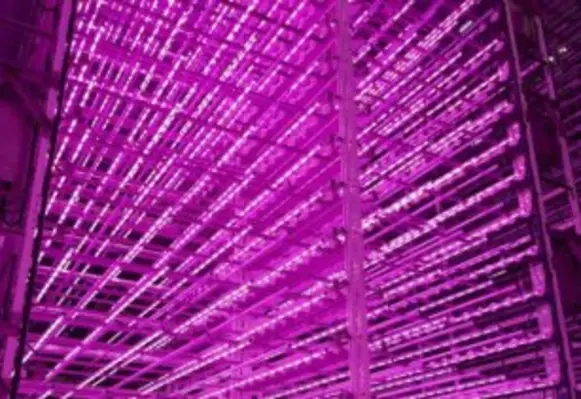The recent IDTechEx report ‘Vertical Farming 2020-2030’ explores the technologies and market factors that shape this rapidly expanding industry
The ongoing argument within the industry is about size – is it better to focus on building a large, highly automated plant factory to minimise production costs, or is a small, more flexible approach the best way to set up a vertical farm?
This question arises from some of the challenges facing the vertical farming industry. Setting up and running a vertical farm is not cheap, and many vertical farming companies have struggled to overcome spiralling labour and power costs, alongside unforeseen logistical complexities, and problems with maintaining an optimum growing environment.
A potential solution to some of these problems is the construction of a very large vertical farm, which allows the power costs to be averaged over a large quantity of crops. In addition, large vertical farms make it easier to justify the use of advanced automation systems that can help reduce labour costs, while the cost of automated systems is also spread over large quantities of crops.
Such economies of scale can help a vertical farm to begin to achieve price parity with a conventional farm, something that has long eluded smaller vertical farms, which are often forced to sell products in premium categories. Large vertical farms producing large quantities of crops can also be more easily integrated into existing food supply chain structures, for example, next to the main distribution centre of the supermarket.
One company trying to use this scale-based approach is the Jones Food Company, a British vertical farm start-up that currently operates the largest vertical farm in Europe. The company believes that the only way for vertical farming to be successful in the long term is to achieve price parity with conventional farming, which it hopes to achieve through automation and the operation of large scale facilities near distribution centres.
The company draws its inspiration from car factories – it is far more cost-effective to produce cars in a large central plant than it would be to produce them in small premises near dealerships, and Jones Food Company believes that the same logic applies to vertical farming.
Crops grown in distribution centres are still able to reach consumers quickly, often within a day of harvesting, and the company does not believe that the hyper-local model promoted by certain competitors is worth the inefficiencies and costs of many small facilities located in city centres.
Several other vertical farmers are following this approach, with New Jersey’s start-up, AeroFarms, announcing in 2019 that it would invest US$42mn to build a 150,000sq foot facility in Danville, Virginia, which the company claims will be the largest in the world. Jeff Bezos-backed Plenty operates a 52,000sq foot facility in South San Francisco to maximise production efficiency to improve the economy of vertical farming.
Not everyone, however, agrees with this large-scale approach. Large installations and automation are expensive, with large installations costing tens of millions of dollars. While this approach may make sense for a car manufacturing plant or other high-margin products, for low-margin products such as fresh produce, it may take decades to repay this initial investment.
In addition, supply and demand for fresh produce are not always consistent, and pricing can often change, making it difficult to predict investment returns accurately, which can be very problematic for a vertical farm that has cost several million dollars to build. Moreover, many of the processes required to grow crops can not yet be addressed through off-the-shelf automation solutions, creating difficult engineering challenges that can make scale-up very complicated.
Another problem for very large vertical farms is that the operational complexity can increase considerably for larger farms. Plants are living organisms that can act in unpredictable ways, making it difficult to grow them in a way that resembles a factory production line. Plants emit heat and water vapour as they grow, while also requiring supplies of carbon dioxide and oxygen, in addition to nutrients.
Keeping crop inputs consistent across the entire vertical farm and managing waste heat and water vapour can also be very difficult in a high density growing area. Careful consideration of plant science, together with the planning of a logistic workflow to maximise efficiency, is needed to successfully operate a large-scale vertical farm.
As a result of these challenges, some companies have instead chosen to focus on smaller vertical farming facilities, choosing to focus on flexibility instead of economies of scale. For example, Freight Farms, which manufactures turnkey, modular vertical farms inside 40' containers, believes that smaller vertical farms provide a more flexible and targeted business model than large, centralised facilities.
Small vertical farms can be tailored to certain markets with gaps, such as crops that can't be imported, and transient falls in supply for high-demand crops and restaurants or food suppliers that need a specific ingredient. These are all markets in which large, warehouse-like, vertical farms are not easily accessible.
Rather than focusing on mass-produced, wholesale crops, where vertical farms will always struggle to compete on price with traditional farms and greenhouses, it may make more sense for vertical farm operators to focus on high-value crops with price premiums, perhaps on niche markets or on specialised applications.





